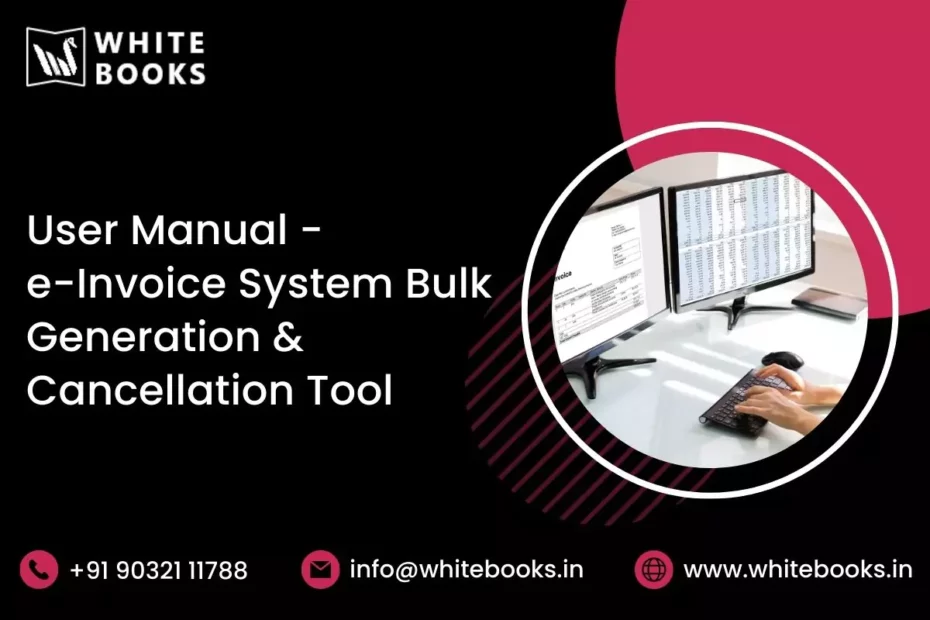Table of Contents
1. Introduction
1.1 Background
The GST Council has approved the implementation of e-invoicing, also known as electronic invoicing, in a phased manner for reporting business-to-business (B2B) invoices to the GST System in India. After consultations with trade and industry bodies, a standardized format has been finalized to ensure seamless interoperability of e-invoices across the entire GST ecosystem. Introducing a standard is crucial to enable different software systems to read e-invoices generated by one another, eliminating the need for manual data entry and reducing errors. The key objective is to achieve machine readability and uniform interpretation of e-invoices. This standardization will benefit the GST System and facilitate the efficient sharing of e-invoices among sellers, buyers, banks, agents, and other players in the business ecosystem. Considering the large volume of business transactions and the use of diverse, non-standardized invoice formats in India, implementing e-invoicing will be a significant step forward. The goal is to ensure interoperability and uniform interpretation of e-invoices through machine readability.
1.2 Purpose and Intended Audience
The purpose of this document is to provide an operational procedure for using the offline tool to generate bulk e-invoices. It is designed to be helpful for taxpayers, tax consultants, and software companies in adopting the standardized process.
This document is specifically intended for registered taxpayers under the Goods and Services Tax (GST) system, as they are the primary stakeholders of the e-invoice system under GST.
1.3 URL or Website Address
The URL or website address for accessing the e-invoice system is https://einvoice1-trial.nic.in/. This website provides users access to the e-invoice system to generate and manage e-invoices.
2. What is E-invoice?
E-invoicing is a process in which invoices created by accounting software are electronically authenticated by the GSTN (Goods and Services Tax Network) for various purposes, such as return preparation and e-way bill creation. It is important to understand that e-invoicing does not involve generating or creating invoices from a central portal or tax department. This approach would create unnecessary restrictions on trade and industry, as different industries have different business requirements that a one-size-fits-all software solution cannot meet.
Instead, e-invoicing involves submitting already generated invoices from accounting software to the GST Portal. Accounting and billing software systems often use their formats to store invoice information electronically, making it difficult for the GST System to interpret the data. To address this, a standardized format (schema) has been introduced. All accounting and billing software must implement this standard schema, which enables them to generate a JSON file for each invoice in a format that can be uploaded to the GST Portal for authentication and approval.
From the user’s perspective, the process of creating invoices remains the same, whether for printing or electronic creation. The key change lies in implementing the standardized schema for generating the JSON file, allowing seamless integration with the GST System.
2.1 Benefits of the E-Invoicing System
Implementing the e-invoicing system brings several benefits to businesses and the overall taxation process. Some of the major benefits include:
- Standardization: One-time reporting of B2B invoice data in the format it is generated, reducing the need to report in multiple formats (such as for GSTR-1 and e-way bills).
- Automation: Auto-generation of Sales and Purchase Registers (ANX-1 and ANX-2) based on the e-invoice data. This helps generate sales and purchase registers required for filing returns under the New Return system. E-way bills can also be generated using e-invoice data.
- Seamless Reconciliation: Easier reconciliation and data verification between suppliers and recipients lead to better control over input tax credit computation and claims.
- Reduced Compliance Burden: Overall reduction in compliance burden for businesses. With the e-invoice data being reported to the tax department and buyers’ inward supply register, there is a substantial reduction in input credit verification issues.
- Elimination of Fake Invoices: The system-level matching of input credit and output tax helps reduce tax evasion and identify fake invoices.
- Information Availability: Near real-time availability of information to all relevant participants in the supply chain, enabling better decision-making and transparency.
- Improved Reconciliation: Buyers can promptly reconcile the e-invoice data received from the GST system with their purchase orders, facilitating efficient reconciliation processes under the New Return system.
- Environmental Benefits: The elimination of paper-based way bills results in significant paper savings, making the process more environmentally friendly.
- Efficiency for Officials: The e-invoicing system reduces the manual work involved in collecting and matching data with taxpayer returns, freeing officials to focus on more valuable tasks.
Overall, the e-invoicing system brings efficiency, standardization, and transparency to the invoicing and taxation processes, benefiting businesses and tax authorities.
2.2 Objective of E-Invoicing System
The objective of implementing the e-invoicing system in India is to address the challenges posed by the high volume of business transactions and the variety of non-standardized invoice formats. The key objective is to achieve interoperability across the entire GST ecosystem, ensuring that an e-invoice generated by one software can be read and interpreted by any other software. This is achieved through machine readability, which enables uniform interpretation of invoices.
Additionally, the e-invoicing system aims to make invoice reporting an integral part of the business process, eliminating the cumbersome task of compiling invoices at the end of a return period. A major challenge tax authorities face is the fraudulent claiming of fictitious Input Tax Credit (ITC) through the issuance of fake invoices. The e-invoice system helps address this challenge by providing real-time access to data, enabling tax authorities to identify and prevent fraudulent activities.
By implementing the e-invoicing system, the objective is to enhance transparency, streamline invoice reporting, and reduce instances of tax fraud. It enables tax authorities to have better control and access to real-time data, ensuring the integrity of the taxation system. The objective is to promote efficiency, accuracy, and compliance in invoicing and tax processes.
2.3 Stakeholders of the E-Invoicing System
The introduction of e-invoicing aims to cater to the expectations and concerns of various stakeholders, particularly about utilising the Input Tax Credit (ITC). The key stakeholders involved in the e-invoicing system include:
- Taxpayers: Registered taxpayers are the primary stakeholders under the Goods and Services Tax (GST) system. They are responsible for generating and submitting e-invoices, complying with the e-invoicing requirements, and utilising the benefits of a standardised invoicing system.
- Tax Authorities: The tax authorities, such as the GST Network (GSTN) and the Central Board of Indirect Taxes and Customs (CBIC), play a crucial role in implementing and regulating the e-invoicing system. They oversee taxpayers’ compliance, ensure data security and integrity, and leverage e-invoice data for effective tax administration and enforcement.
- Software Companies: Software companies that develop accounting and billing software are important stakeholders. They must incorporate the standardised e-invoicing schema into their software solutions to enable taxpayers to generate e-invoices in the prescribed format. These companies are critical in facilitating seamless integration between their software and the GST ecosystem.
- Tax Consultants: Tax consultants and professionals who provide advisory services to businesses regarding GST compliance are also stakeholders. They need to stay updated with the e-invoicing requirements and assist their clients in implementing the necessary changes in their invoicing processes and software systems.
- Trade and Industry Bodies: Trade associations and industry bodies represent the interests of businesses across various sectors. They actively participate in consultations and discussions with the government and tax authorities to provide inputs on the e-invoicing system’s design, functionality, and business impact.
The objective of e-invoicing is to address the expectations and concerns of these stakeholders by leveraging the benefits of standardised invoicing, particularly in terms of efficient utilisation of Input Tax Credit. The e-invoicing system aims to create a transparent and compliant business environment for all stakeholders involved by streamlining invoicing processes, enhancing data accuracy, and reducing tax evasion.
3. Offline Method of Bulk IRN Generation
For large businesses that generate a high volume of invoices, manually generating the Invoice Reference Number (IRN) can be time-consuming. The Invoice Registration Portal (IRP) provides a bulk IRN generation facility to simplify the process. This allows taxpayers to upload multiple invoices at once for IRN generation.
The responsibility of generating the IRN lies with the supplier. They must upload the invoices to the Invoice Registration Portal (IRP) for authentication. Once the invoices are verified, the portal will generate a unique IRN and digitally sign the e-invoice with a QR code.
3.1. The e-invoice system implemented by tax departments globally consists of two key components:
- Generation of Invoices in a Standard Format: The e-invoice system requires invoices to be generated in a standardized format that different systems can easily interpret. This ensures compatibility and interoperability between different software systems used by suppliers and buyers.
- Reporting of E-Invoices to a Central System: The generated e-invoices are reported to a central system, such as the Invoice Registration Portal (IRP), for further processing and authentication. The central system validates the invoices, assigns unique IRNs, and digitally signs the invoices for authenticity.
By adopting the offline method of bulk IRN generation, businesses can streamline their invoice processing, reduce manual effort, and ensure compliance with e-invoicing requirements. This method allows for the efficient handling of many invoices while maintaining the integrity and authenticity of the e-invoice data.
3.2. Step-by-Step Process to Generate Invoice Reference Number (IRN) Using Offline Method:
- Visit the e-invoice portal, specifically the trial e-invoice portal.
- Navigate to the “Help” section and find the “Tools” option. Click on “Bulk Generation Tools.”
- In the Bulk Generation Tools section, you will find four different JSON preparation tools: Format A, Format B, Format C, and Format D. These formats are designed to meet the requirements of different types of taxpayers and transactions.
- Choose the most appropriate format and download the corresponding JSON preparation tool.
- Ensure that you have Microsoft Office 2010 or a higher version installed on your computer, as the JSON preparation tool requires this software.
- Open the downloaded JSON preparation tool using Microsoft Office.
- Enter the necessary details and invoice data into the tool per the specified format.
- Save the completed JSON file containing the invoice data on your computer.
- Return to the e-invoice portal and navigate to the offline tool section.
- Upload the saved JSON file containing the invoice data.
- The e-invoice system will authenticate and validate the uploaded data.
- Once the data is verified, the system will generate the Invoice Reference Number (IRN) for each invoice in the JSON file.
- The system will digitally sign the e-invoices and generate a QR code for each.
- You can download the digitally signed e-invoices along with the respective QR codes.
- Incorporate the generated IRN and QR code into your invoice for further processing and compliance.
By following these steps, taxpayers can utilize the offline method to generate multiple Invoice Reference Numbers (IRNs) in one go. This process enables efficient and accurate generation of e-invoices, ensuring compliance with the e-invoicing requirements.
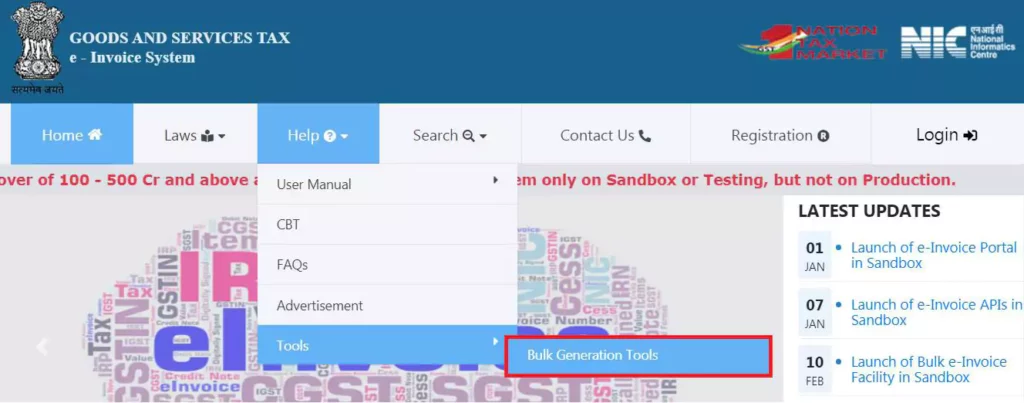
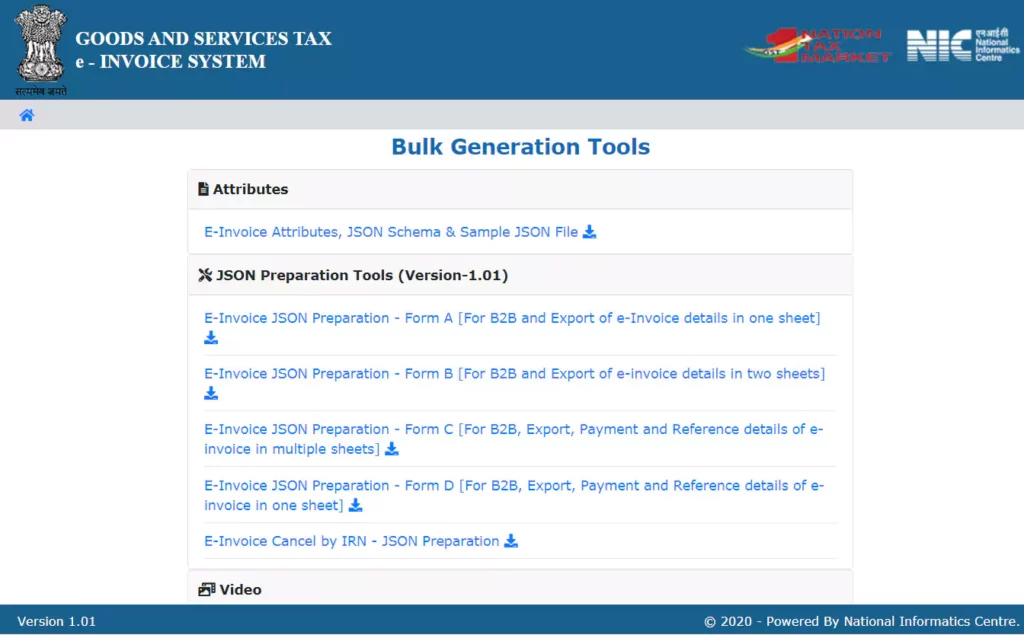
E-Invoice JSON Preparation – Format A:
Format A in the E-Invoice JSON Preparation is designed for businesses with 1 or 2 items in the invoice. It consists of a single worksheet where invoice and item details can be entered to prepare the JSON file for uploading many e-invoices to the Invoice Registration Portal (IRP). This format is suitable for invoices with Business-to-Business (B2B) transactions.
Here are some key points to note about Format A:
- Worksheet Structure: Format A includes a single worksheet to enter the necessary details.
- Seller GSTIN Details: The seller’s GSTIN details are entered in the Profile section as a one-time entry.
- Item Details: Enter the item details in the same worksheet. Ensuring that the invoice details repeat for all the items in the invoice is important.
- Payment and Reference Details: Format A does not allow entering payment and reference details. If your invoices require these details, consider using other formats like Format B, Format C, or Format D.
By using Format A, businesses with a small number of items in their invoices can efficiently generate the JSON file for bulk upload to the IRP. This streamlines the process of e-invoice generation and ensures compliance with the e-invoicing requirements.

E-Invoice JSON Preparation – Form B:
Format B in the E-Invoice JSON Preparation consists of two worksheets, allowing for separate invoice and item details entries. This format is recommended for businesses with many items in their invoices. It provides a structured approach to handling multiple items efficiently. Here are some key features of Format B:
- Worksheet Structure: Format B includes two worksheets for invoice and item details.
- Invoice Details: Enter the relevant details in the first worksheet. This includes the seller’s GSTIN, invoice number, invoice date, etc. You can also enter export details and part-B details for generating an e-waybill.
- Item Details: Enter the item-specific details in the second worksheet. Each item should be referenced with the document number, document type, and document date of the invoice to which it belongs.
- Payment and Reference Details: Similar to Format A, Format B does not allow entering payment and reference details.
By using Format B, businesses with many items in their invoices can effectively organize and enter the necessary details. The separate worksheets for invoices and items help ensure clarity and accuracy in data entry. However, payment and reference details need to be managed outside the JSON preparation tool.


E-Invoice JSON Preparation – Form C:
Format C in the E-Invoice JSON Preparation is designed with five worksheets, allowing for separate entries of invoice details, item details, payment details, reference details, and additional details. This format is particularly suitable for businesses with invoices containing multiple items and requiring complete payment and reference information. Here are the key features of Format C:
- Worksheet Structure: Format C includes five worksheets, each dedicated to specific types of information: invoice details, item details, payment details, reference details, and additional details.
- Invoice Details: Enter the relevant details in the “Invoice” worksheet. This includes the seller’s GSTIN, invoice number, invoice date, and export details. If an e-waybill needs to be generated, part B details can also be entered in this worksheet.
- Item Details: Enter the item-specific details in the “Item” worksheet. Each item should be referenced with the document number, document type, and document date of the invoice to which it belongs.
- Payment Details: Enter the payment-related information in the “Payment” worksheet. This can include details such as payment method, payment terms, and other relevant information.
- Reference Details: Enter any reference details associated with the invoice in the “Reference” worksheet. This can include references to purchase orders, contracts, or other relevant references.
- Additional Details: Use the “Additional” worksheet to enter any additional information that may be required for the invoice.
By using Format C, businesses can comprehensively capture invoices, items, payments, references, and additional details in separate worksheets, ensuring clarity and accuracy in data entry. This format is well-suited for invoices with multiple items and the need for comprehensive payment and reference information.



E-Invoice JSON Preparation – Form D:
Format D in the E-Invoice JSON Preparation involves a single worksheet where invoice details, item details, payment details, reference details, and additional details can be entered together. This format is specifically designed for businesses with many items in their invoices, requiring payment and reference details. Here are the key features of Format D:
- Worksheet Structure: Format D utilizes a single worksheet where all the relevant information is entered. This includes invoice details, item details, payment details, reference details, and additional details.
- Invoice Details: Enter the necessary invoice details, such as the seller’s GSTIN, invoice number, invoice date, and export details, directly in the same worksheet.
- Item Details: Enter the item-specific details and invoice details within the same worksheet. This allows for the inclusion of many items in the invoice.
- Payment Details: Enter the payment-related information within the same worksheet. This can include payment methods, payment terms, and any other relevant payment details.
- Reference Details: Include any reference details associated with the invoice directly in the same worksheet. This can encompass purchase order references, contract details, or other relevant references.
- Additional Details: Enter any additional information required for the invoice within the same worksheet.
If an e-waybill needs to be generated, the part-B details can be entered directly into the Invoice sheet. By using Format D, businesses with invoices containing many items can conveniently enter all the necessary details, including payment and reference information, in a single worksheet. This format streamlines the data entry process and ensures that all the required information is captured accurately in one place.




After downloading the utility mentioned above, follow these steps:
Step 1: Enter all the seller GSTIN details as required in the ‘Profile’ sheet.
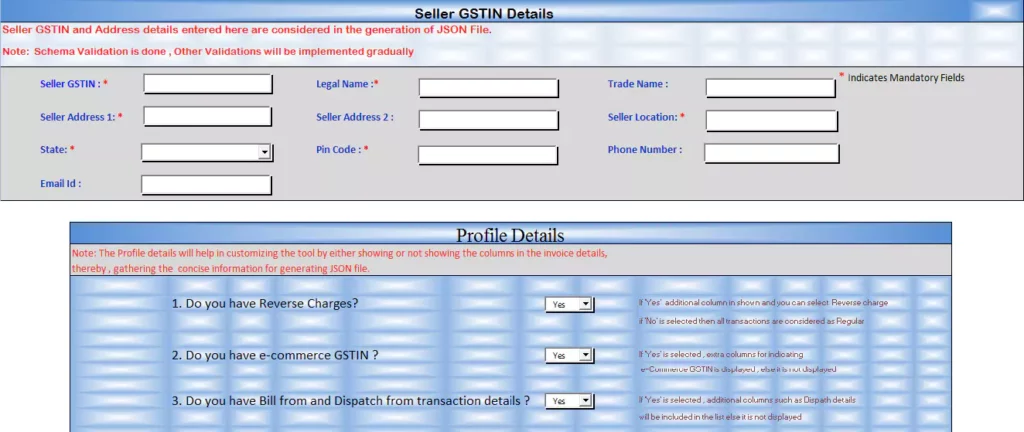
Step 2: Enter all the details of the invoices in the necessary fields as given in the ‘Invoice’ sheet.
Step 3: Once the invoice details are entered, to ensure that the e-invoice schema is followed, validate the details using the ‘Validate’ button.
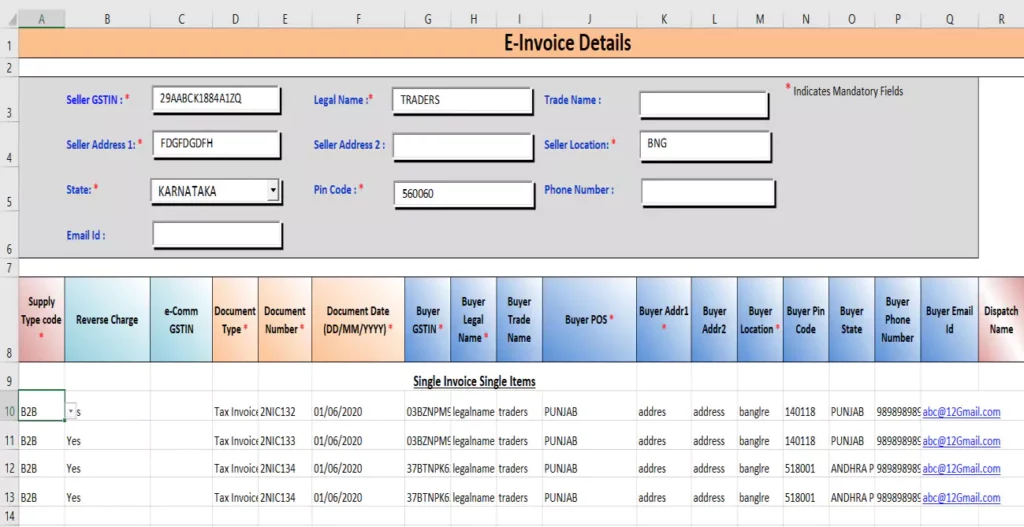
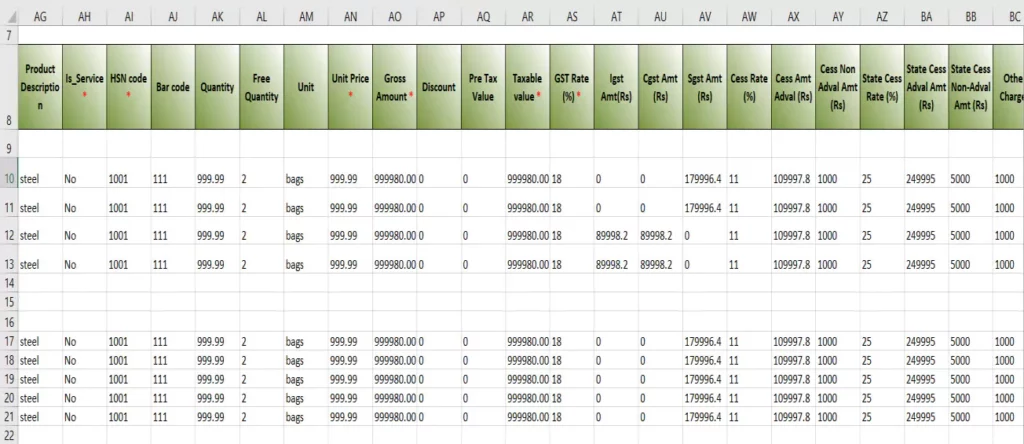
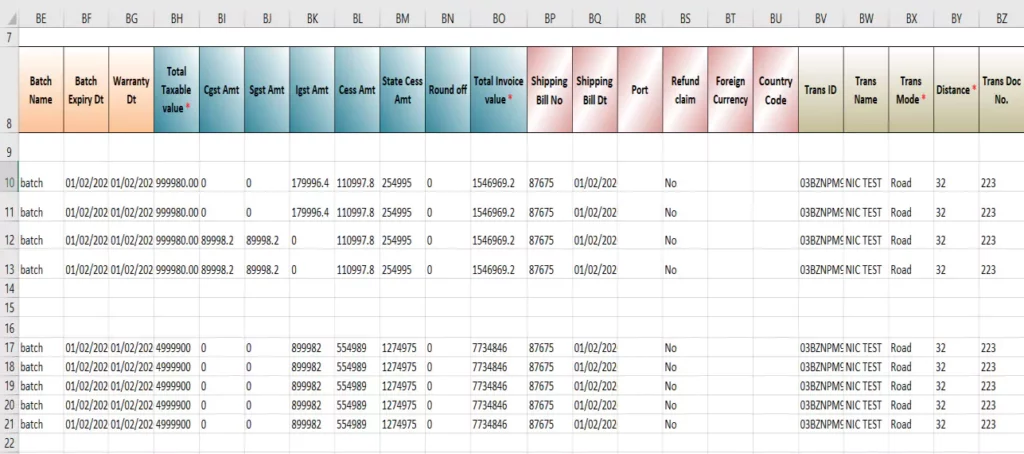
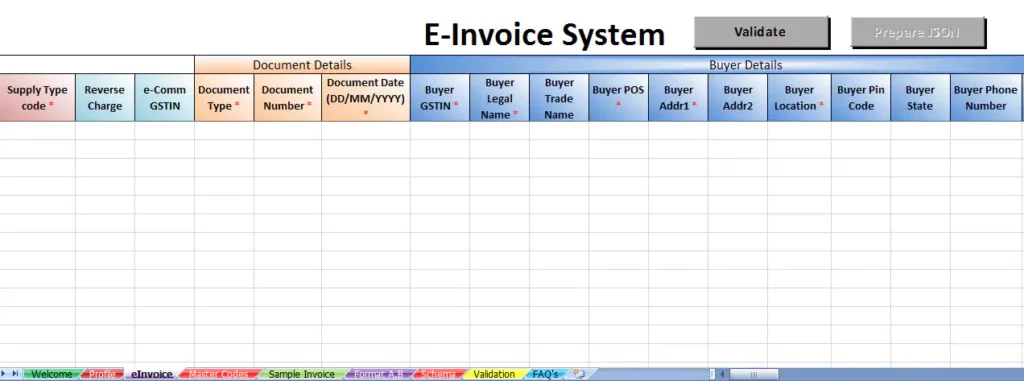
Step 4: Upon successful validation, click the ‘Prepare JSON’ button. The JSON file containing details of the multiple invoices entered will now be generated. Taxpayer logs in to the E-Invoice system and uploads the file containing the multiple requests for IRN. Ensure that the size of the JSON file is not more than 2MB. The system then generates the IRN for all these requests one-by-one and shows the result in a table. A summary of the contents of the JSON file will be displayed. Otherwise, it shows error details. The table details can be downloaded into the user’s system for further use and action.
Note: Read all the instructions, specifications, and validations in the welcome sheet of the tool. This will guide you on how to proceed further. You can refer to the master codes and validation sheets to cross-verify that the data entered is valid. Also, you can refer to the sample e-invoice sheet for sample invoices entered.
Generating Bulk IRN
To generate bulk Invoice Reference Numbers (IRNs), follow these steps:
Step 1: Select the “Bulk Upload” option under the “e-invoice” section. This option can be found in the user interface. Clicking on this option will display the following screen.
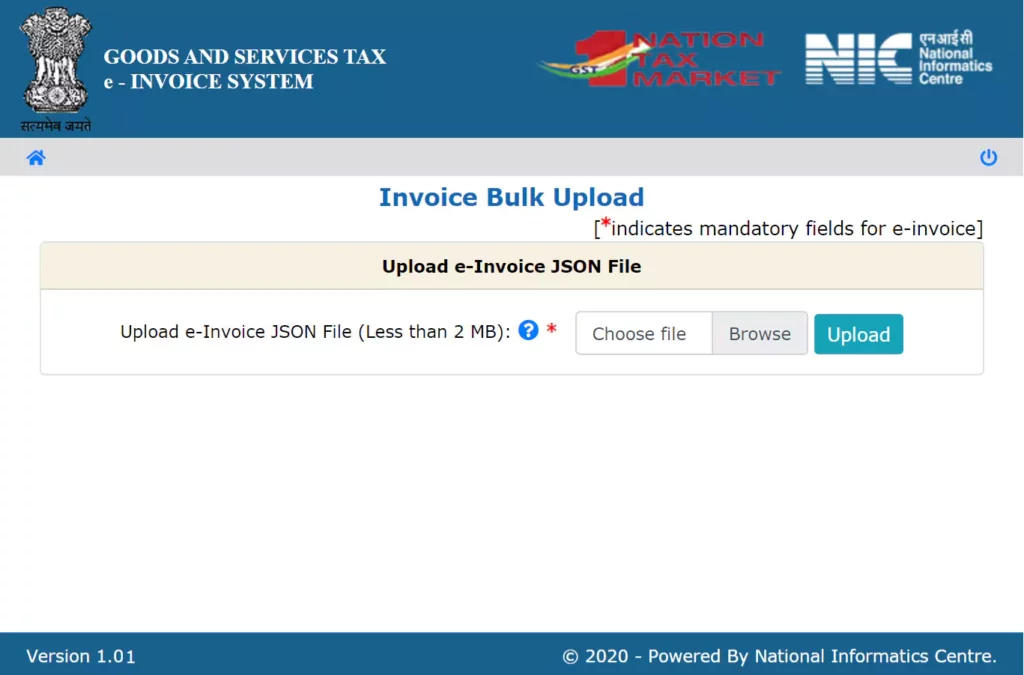
Step 2: Upload JSON: Click the “Browse” button and select the JSON file containing the IRN request. The file should be within the maximum allowed size limit of 2 MB. After selecting the file, the system will upload the IRN request file to the e-invoice system. Once uploaded, the following screen will be displayed.
Step 3: Generation of IRN: Click on the “Confirm” button to initiate the processing of the JSON file. The system will process the file and generate e-invoices. The system will display a 64-character length Invoice Reference Number (IRN) for each request. Appropriate error messages will be shown for each request if any issues arise during the processing.
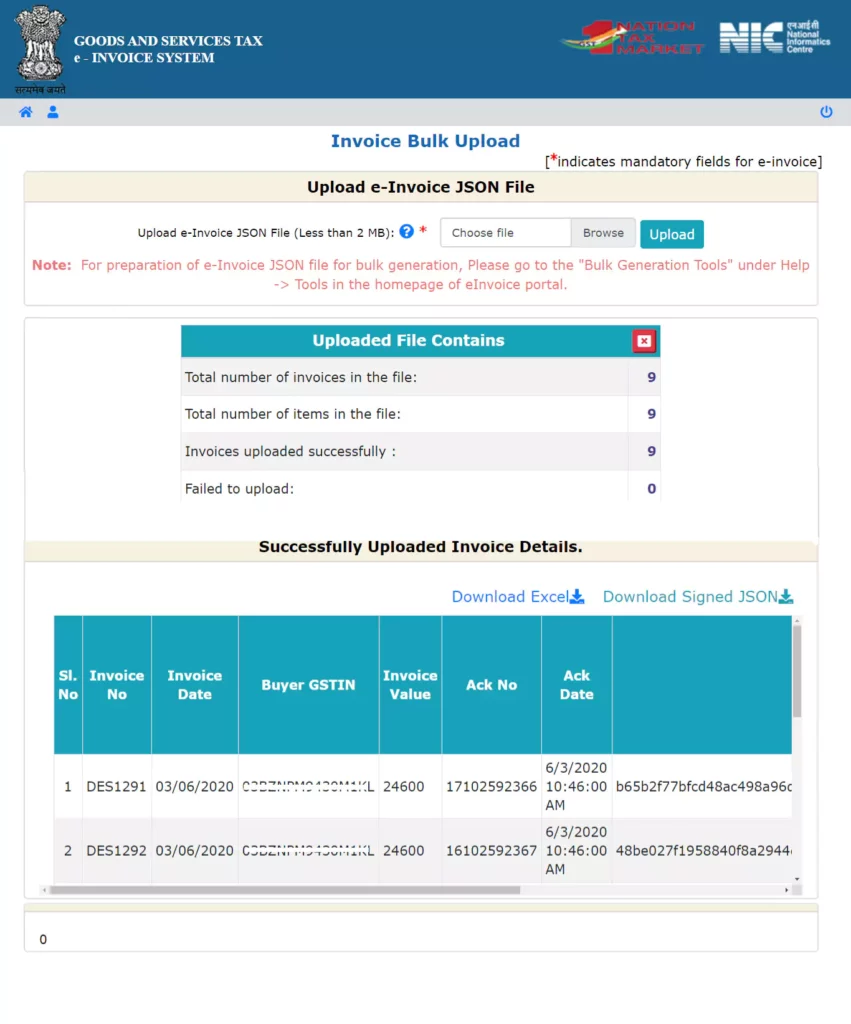
Additionally, the user can export the e-invoices in an Excel file by clicking on the “Download Excel” button. The IRN, a 64-character length unique identifier for each invoice, will serve as the unique identifier for a taxpayer’s entire financial year within the GST system.
It’s worth noting that the system will also update the invoice details in the E-Waybill system. The E-Waybill system will utilize this data to generate Part-A of the e-way bill, and the user will need to attach the vehicle number in Part-B of the e-way bill. By following these steps, you can generate bulk Invoice Reference Numbers (IRNs) efficiently and accurately.
4. Bulk IRN Cancellation
To cancel Invoice Reference Numbers (IRNs) in bulk, follow these steps:
Step 1: Access the “Bulk IRN Cancel” sub-option under the “E-invoice” section in the menu. By selecting this option, the following screen will be displayed.
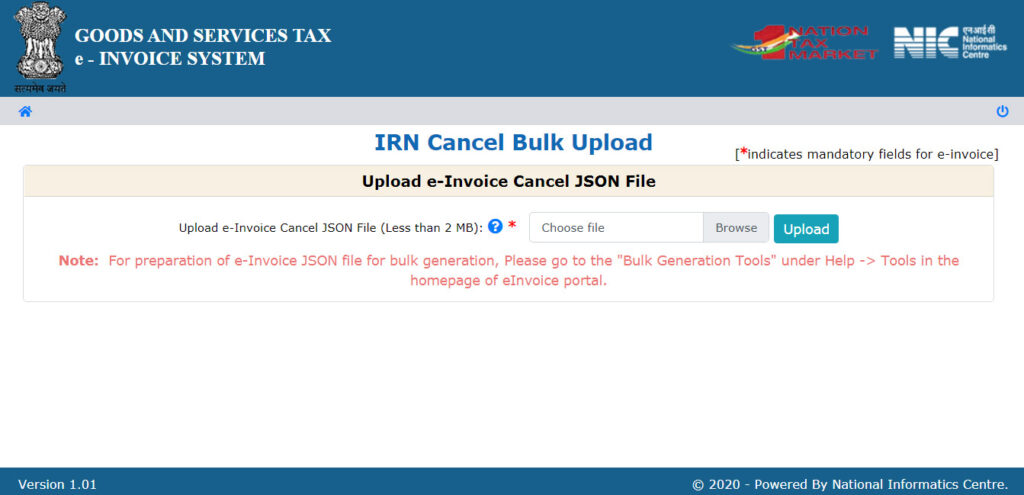
Step 2: Upload JSON: Click the “Browse” button to select the JSON file containing the Bulk IRN Cancel request. The file size should be the maximum allowed limit of 2 MB. Upload the file to the e-invoice system.
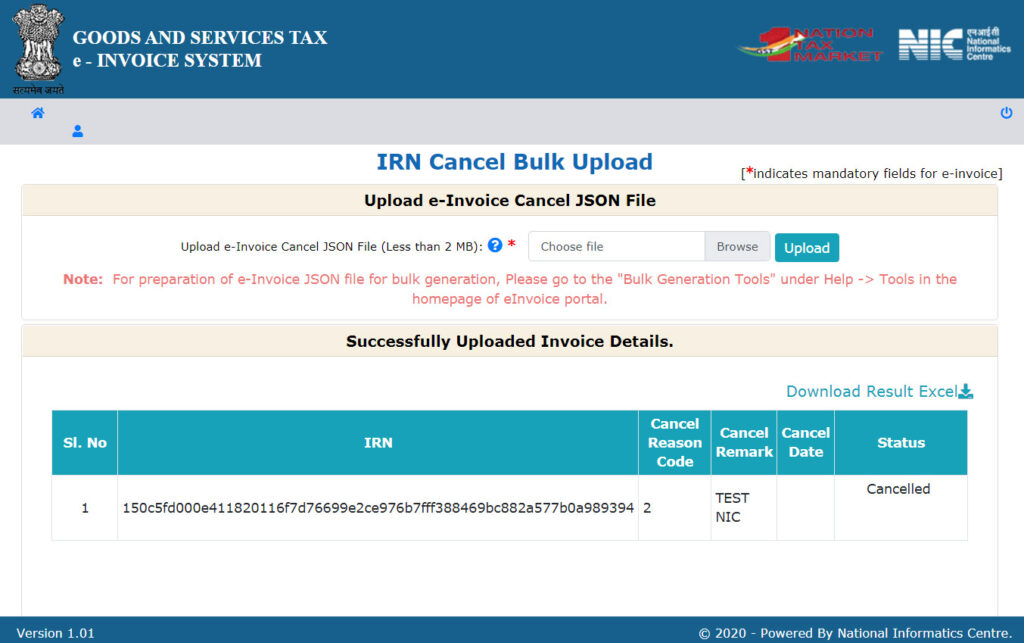
Step 3: After the JSON file is processed, the e-invoice system will cancel the IRNs and display the status as “cancelled.” If any issues prevent cancellation, the system will show the appropriate error message for each request.
It is important to note that before initiating the bulk IRN cancellation, the user should have the “e-Invoice Cancel by IRN JSON File” ready, which contains the IRNs intended to be cancelled. To prepare this JSON file, you can download the “E-Invoice Cancel by IRN – JSON Preparation” tool from the “Bulk Generation Tools” section under “Help -> Tools” on the homepage of the e-invoice portal.
By following these steps and ensuring the availability of the necessary JSON file, you can easily cancel Invoice Reference Numbers (IRNs) in bulk for reasons such as incorrect entry or duplicate entry.
5. E-waybill Generation using Invoice Registration Number (IRN)
To generate a Bulk e-Way Bill using Invoice Reference Numbers (IRNs), follow these steps:
Step 1: Access the “Bulk E-Way Bill” sub-option under the “E-Waybill” section. By selecting this option, the following screen will be displayed.
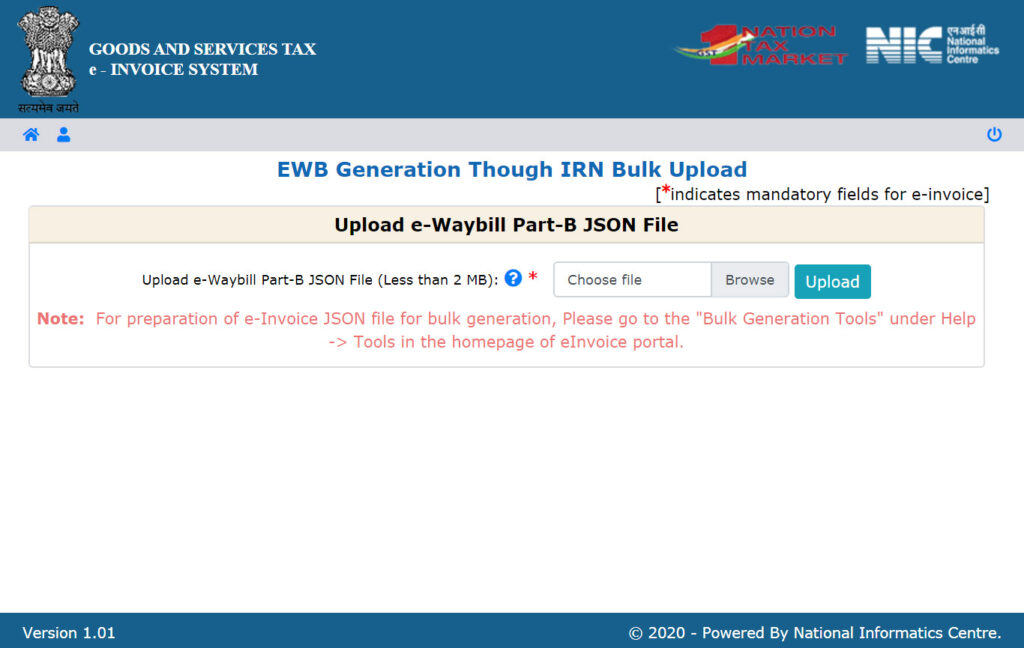
Step 2: Upload JSON: Click the “Browse” button to select the JSON file containing the Bulk E-Way Bill through IRN request. The file size should be the maximum allowed limit of 2 MB. Upload the file to the e-invoice system.
Step 3: After processing the JSON file, the system will generate the E-Way Bills and display a success message. The system will also provide the e-way bill numbers for each request. If any issues prevent E-Way Bills generation, the system will show the appropriate error message for each request.
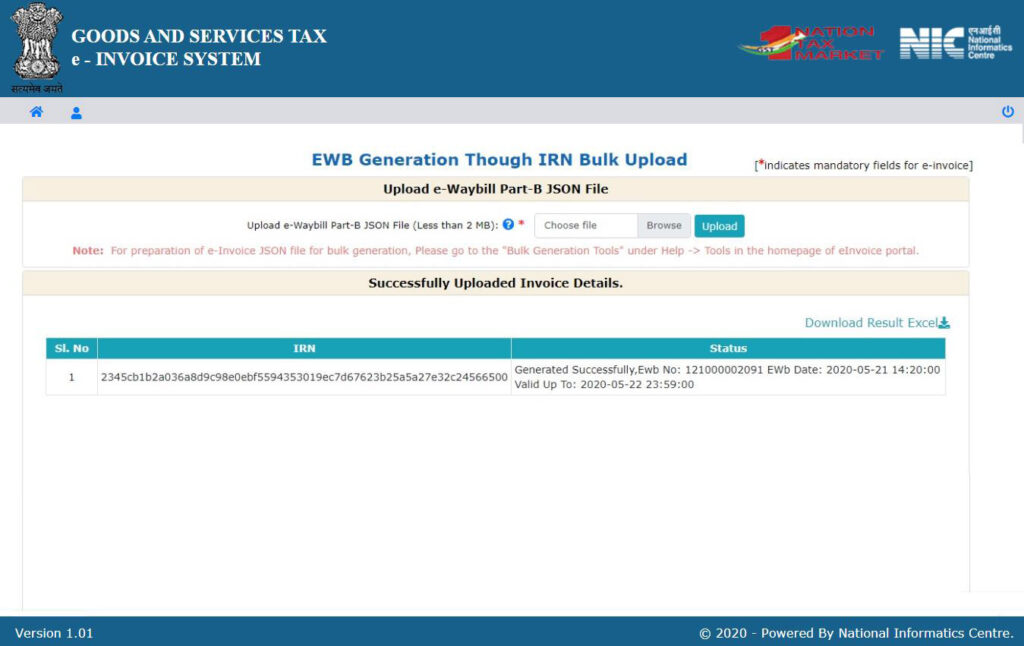
Note: Before proceeding with the Bulk generation of E-Way Bills using IRN, ensure that you have the EWB bulk converter or the Excel file that helps you create the request for multiple E-Way Bills through IRN in a single JSON file. To prepare this JSON file, you can download the “E-Waybill Generation by IRN – JSON Preparation” tool from the “Bulk Generation Tools” section under “Help -> Tools” on the homepage of the e-invoice portal.
By following these steps and ensuring the availability of the necessary JSON file, you can easily generate multiple e-Way Bills using Invoice Reference Numbers (IRNs) in a one-time process.
Summary
In summary, the implementation of e-invoicing in India involves the following key points:
- E-invoices will not be generated at the Invoice Registration Portal (IRP). Instead, businesses will generate e-invoices using their own software or accounting systems following the e-invoice schema issued by the GST system.
- The e-invoice schema contains both mandatory and non-mandatory fields. All taxpayers must fill in the mandatory fields, while the non-mandatory fields are optional and can be chosen based on business needs.
- Each e-invoice will be authenticated with the digital signature of the IRP to ensure its authenticity and integrity.
- Taxpayers must upload their e-invoices for registration on the IRP within the specified timeline.
- The e-invoice system provides an option to cancel an invoice within 24 hours of its registration on the IRP, allowing businesses to rectify any errors or make necessary adjustments.
The e-invoice mechanism aims to streamline and standardize the invoicing process, enhance tax compliance, and provide greater transparency in business transactions.
